The characters in Pocket Paragons have changed a lot over the years, but I’m very happy with where they ended up. In this Pocket Paragons design blog, I wanted to go over a little of their history, the flavor behind their abilities, and some backstory about how they’re named.
As a quick note, I’ve named my characters after those who have helped playtest the game the most, as thanks for suffering through a lot of very bad and unplayable prototypes. There have been a lot of people who have helped along the way, and I’ve changed the names a few times. I blame the fact that there is not enough room for everyone who has helped me in only a few small character’s names, and I apologize to those names that didn’t make the final version.
Sadoh, The Tyrant’s Heir
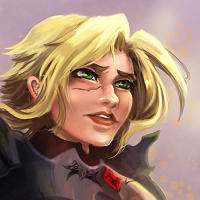
The Tyrant’s Heir was my main character of the story from the beginning. Being the daughter of an evil tyrant and having to overthrow your own father bring a lot of conflict to a character. She has a good heart, but it’s hard for people to trust her because of her lineage.
I wanted to keep this duality of good and evil in her kit as best I could. My favorite tropes in all of storytelling are when good characters turn evil and when evil characters turn good. I loved pro-wrestling when I was a kid, and a good heel turn was always an exciting moment. Sadoh’s kit forces you to choose a path, but make that surprise narrative switch to catch your opponent off guard.
In earlier versions of her kit, she would often replenish her health and abilities at the cost of the health and abilities of her allies. In one light, you could see it as her draining her allies to her own benefit, or in another light, her allies willingly giving their energy up in a show of friendship and teamwork. I wanted you to be able to look at her in different ways, but most of the time it just felt like a vampiric thing more than cooperation.
Sadoh is named after playtester and Solis Game Studio extraordinaire Jessica Solis, who used the tea ceremony-inspired name as a screen name.
Pallash, the Ocean Queen
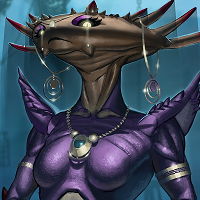
The Ocean Queen was set up to be the antagonist of the story, coming to take the devil’s due after the war against the tyrant was won. I’m a sucker for a good villain, and the Ocean Queen is my favorite piece of art out of them all. I originally wanted a vile and ugly crab monster because I didn’t want all my characters to be good-looking, but Kris blew me away with the powerful and intimidating ocean queen. She was originally named Palawan after the islands, which is why she’s purple like the Palawanese crabs.
The Ocean Queen is a harsh ruler, and her various kits over the years have designed to restrict the opponent in various ways. The cages in the background of her art are ominous and definitely an inspiration for the way she plays. I also fell in love with the punny name of Turn the Tide, which has had a bunch of different comeback type effects but also it’s an ocean joke.
Pallash is named after playtester Ashley Tinoco. Pallace is her online handle, and it’s a portmanteau of that and her first name.
Mata, the Paladin
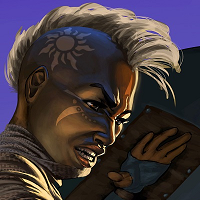
Mata is part of an order of sun-worshippers, and despite a popular video game franchise turning “praise the sun” inadvertently into a meme, I’ve been playing Dungeons and Dragons clerics and paladins of Pelor, Amanautor, and Lathander (the various sun gods) since my childhood, so I had to include that trope here. Mata’s role in the story is to be a spiritual advisor to Sadoh, but her zealous nature often trumps her wisdom.
Paladins and light can pull a character in a number of different directions, and Mata has had probably the most complete overhauls of any of the characters in the game. The retribution side of her was the most exciting and what I ended up building her kit around in the end. Defensive play and healing work well with being able to reflect damage back, and leads to showing off her “eye for an eye” beliefs.
Mata is named for Adrienne Mata, the game’s art director. Adrienne did a lot of the game’s early art and set the tone for the rest of the art.
Kagemusha, the Assassin
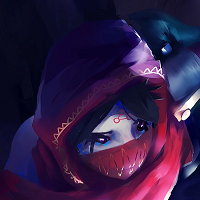
Kagemusha is part of a secret assassin order called the Tears of Agony who use blood magic to enhance their stealth and martial skills. I’m surprised I don’t see more dark magic types combined with rogue types, as they’re both fairly traditional “bad” tropes, but there isn’t a lot of crossover there.
The Assassin’s kit has been based around having a second Execute type ability since Weapons were first introduced to the game. Keeping an enemy scared of being surrounded by death fits into her theme perfectly. The combination style abilities are to show her patience to look for a weak point in her foe and then strike it even harder.
Kagemusha is named for playtester Andrew Advincula, who uses the “shadow warrior” translation as his screen name. He previously went by “Crimson Ninja”, which is why Kagemusha dresses in bright red, despite being a sneaky assassin.
Kairos, the Timebender
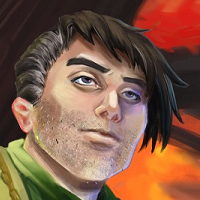
My favorite video game of all time is Final Fantasy Tactics, and my favorite class in that game was the Time Mage, so I had to include one of those in my game. The Timebender was a full-support character in the earlier 3v3 version of the game, and it was tough finding a new kit for him in the 1v1 world of Pocket Paragons.
I struggled with it a lot until I stumbled on the idea of his abilities being tied to the seasons. His Spring ability readies Summer, Summer readies Autumn, and so on. Being able to play them out of order and create different orders of seasons plays into his ability of messing with the timeline. Many of his abilities’ names are pulled from Magic the Gathering cards.
Kairos is named after Nathaniel Kairos Tseng. Nathaniel did a heavy amount of playtesting in the early stages of the game, and his middle name is the Greek word for time. With a name like that, I pretty much had to!
Rosher, the Illusionist
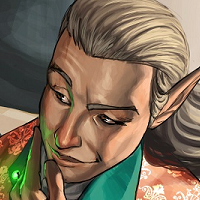
The Illusionist’s original kit was based around the idea of “anything you can do, I can do better”. He often uses illusions to create his favorite subject, himself! The art direction I gave was to have his outfit be reminiscent of the villain Redd White from the first Phoenix Wright game. Bright colors, sparkly all over, and of course, magic rings.
His whole kit was based around copying the enemies and copying the allies, and doing it more effectively. Some of that had to be pulled back when translating the character to the 1v1 nature of Pocket Paragons, but I tried to keep his feel of outsmarting the opponent. Battle of Wits may be my favorite ability in the game! It was inspired by Six-y Beast from Magic the Gathering and the psi game from the Jinteki corp in Android Netrunner. I love having a mind game within the larger mind game of Pocket Paragons as a whole.
Rosher is named for our lead playtester, Nick Rosener. The name is a butchering of his last name and a former nickname of Nick’s.
Quintin, the Guardian

The Guardian’s facial hair and Big Shield are inspired by the League of Legends character Braum, another protector with a great mustache. When the first draft of the Guardian was submitted, he had the shield in one hand in nothing in the other. I asked the artist to add a weapon to his other hand, and the next version returned with him holding an AK-47. It was hilarious, and it hurt my soul a little when I had him change it to a more fantasy-appropriate mace. I hope we’ll get to use that piece of art as a promo or something someday.
The Guardian’s kit had a tumultuous history. His kit of “hey, let’s block a lot” is obvious and straightforward, but at one point we scrapped the Guardian from the game, and I moved his defensive kit to Gamound in the AEGIS box since Gamound is the very defensive character in that game. When we decided to bring back 2 characters for the demo decks, I chose the Guardian and Pyromancer to create a very “defense vs offense” feel. I gave the Guardian a new defensive kit, but I do miss having him block every other round.
Quintin is named after Quintin Smith of Shut Up & Sit Down fame. Quinns was in no way involved in the production or testing of the game, but his early videos with Paul Deen were a tremendous driving force in getting me into tabletop. Without his contagious excitement instilling a love of board games in me, it’s likely I never would have designed Pocket Paragons.
Seris, the Pyromancer
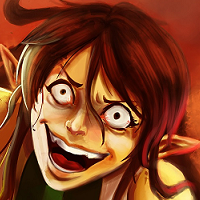
Seris is a cult leader of demon worshippers, and the artist really did a great job bringing out that madness of wanting to see it all burn. I had an old D&D character who was a fireslinger half-elf who mutilated their own ears in dismissal of their elven heritage, but it was probably the right call to not go with something that disgusting in this game. But if you wonder why this character has the elven ears, now you know!
The Pyromancer’s kit has probably been the easiest to keep. It’s hard to mess up “do a lot of damage with fire”, and that simplicity made Seris a good fit for the demo decks. The names of Scarring Cinders and Chaotic Flames are a reference to Dormammu’s special attack voice line in Marvel vs Capcom 3.
Seris is named after playtester Jaryd Hutchins, who uses it as his screen name as well as part of the title of his own game, Solaris. Jaryd avidly hates healing in games, thinking it drags them out too long, which is why Seris has always had anti-healing effects in her kit.
That covers the eight characters of Pocket Paragons! The characters of Temporal Odyssey and AEGIS aren’t my creative creations, so I don’t have as much of a backstory on them. I tried to match the characters’ abilities (and especially the ability names) to their options in their individual games, and it’s a tremendously fun design challenge to do so.
We’re planning on doing more game crossovers for Pocket Paragons in the future, and I look forward to designing kits for pre-existing characters! Thanks for tuning into today’s Pocket Paragons design blog!
-Brian McKay